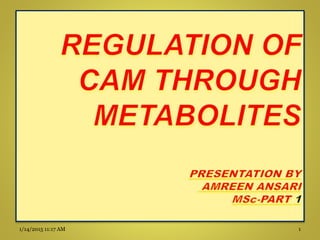CAM PATHWAY
- 1. 1/14/2015 11:17 AM 1
- 2. ? CAM stands for -------------- ? Discovered by Heyne (1804) and later by Aubert (1815). ? Term coined by Ranson and Thomas (1940) ? Mechanism for concentrating CO2 ? CAM is not restricted to the family Crassulaceae ? Enables plants to improve H2O Efficiency ? CAM plants have advantage in dry environment 1/14/2015 11:17 AM 2
- 3. 1/14/2015 11:17 AM 3 CAM can be defined according to the following criteria ?Succulents plants ?Diurnal fluctuation of organic acid ?High activities of PEP carboxylase ?Stomata opening ?Tropical origin and xeric ?CAM permits much flexibility and permits survival
- 4. 1/14/2015 11:17 AM 4 CAM PLANTS
- 5. 1/14/2015 11:17 AM 5 CO MALIC ACID OAA K* MALATE MALATE PYRUVIC ACID CO2 C3 CYCLE PYRUVATE STARCHSTARCH PEP
- 6. 1/14/2015 11:17 AM 6
- 7. 1/14/2015 11:17 AM 7 ? Do photosynthesis in the day time ? Indeed slow growing but they are very competitive ? Advantage in water saving ? Can use Calvin cycle alone ? CAM plants are facultative
- 8. 1/14/2015 11:17 AM 8 ? Requires PEPc and decarboxylase ? To avoid futile cycle : carboxylase at night and decarboxylase during day ? Conversion achieved by ------
- 9. C4 vs CAM Summary 1/14/2015 11:17 AM 9 C4 plants separate 2 steps of C fixation anatomically in 2 different cells CAM plants separate 2 steps of C fixation temporally at 2 different times ItĄŊs all in the timing!
- 10. 1/14/2015 11:17 AM 10 ? PHOTOSYNTHETIC SYSTEMS BY SUSAN M. DANKS, E.HILARY EVANS PETER A. WHITTAKER ? CAM BY IRWIN. P. TING MARTIN GIBBS ? PLANT PHYSIOLOGY BY TEIZ AND ZEIGER
- 11. 1/14/2015 11:17 AM 11
Editor's Notes
- Amreen










